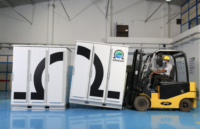The developer of the $3-billion Projet Mauricie, set to be one of Canada’s largest green hydrogen projects, has awarded its first key engineering contract to AtkinsRéalis Inc.
The Quebec project, intended to produce 70,000 metric tons annually of green hydrogen in the province’s emerging industrial decarbonization hub, will include construction of a purpose built electrolyzer, 1,000 MW of wind and solar energy facilities and a network of transmission lines and substations, developer TES Canada said.
Neither firm disclosed the value of the front-end engineering and design contract.
Green hydrogen produced by the project, announced last year, will be used to decarbonize long-haul transportation and industrial sectors, and produce renewable natural gas.
The owner said Projet Mauricie is set to start construction in 2026 for a 2028 targeted operation. “It could be multiple contractors, it could be a single contractor so that’s what we’re trying to determine at the moment,” said Andrew Romano, who directs the renewable energies portfolio of AtkinsRéalis, formerly SNC Lavalin Inc.
“This is largely new infrastructure strategically placed close to existing Hydro Quebec service corridors,” he said. This includes the utility’s “existing and very robust power grid that uses a lot of hydro power to generate clean energy,” Romano added.
The project is located in what is called the Vallée de la Transition Energétique between Montreal and Quebec City in an industrial corridor near the St. Lawrence River, which was designated last year by the Quebec and Canada governments as an energy transition innovation hub.
Set to be completed in Becancoeur, Quebec, within the hub, are two major U.S automaker plants to produce materials for electric vehicles that were announced within the last two years.
One is a $443-million factory, being built by General Motors and South Korean industrial materials maker POSCO Future M, which will manufacture cathode-active components key to EV lithium-ion batteries. It is set to open in 2025. The federal and province governments last year announced they will provide $221 million in funding to the plant.
Set to open by mid-2026 is an $887-million cathode production facility of Ford Motor Corp. and two South Korea energy sector firms—SK On and EcoProBM—with capacity to manufacture 45,000 metric. Its 3-million-sq-ft footprint will include a six-floor building.
Design Powers Up
For facilities' green power design, AtkinsRéalis and consulting engineer BBA, both Montreal-based, will develop Projet Mauricie plans, execution schedule, cost estimates and environmental impact assessments, also assisting in geotechnical investigations, permitting and stakeholder and community engagement.
“This is an amazing project, the largest project in Quebec for decarbonization,” said Jean-Benoît Courchesnes, TES Canada vice president of business development. He called Projet Mauricie “well-structured,” with each component “well defined.”
The project will incorporate an existing 150 MW transmission line to provide basal power to the new electrolyzer, with new production and storage facilities, as well as wind turbines, a collector network and access roads. “Real, tangible infrastructure is planned here,” said Romano.
Pierre-Olivier Pineau, research chair in energy sector management at the public business school, HEC Montreal, says securing a base of 150 MW of renewable energy from Quebec Hydro is “clever,” but he TES Canada needs to "make sure there is a business model that can sustain such a project.”
Projet Mauricie has already contracted its entire renewable natural gas production to Montreal-based energy distributor Énergir Inc. on a long-term, fixed-price contract, Courchesnes said.
"The remaining green hydrogen production, up to 30,000 tons per year, will be sold on shorter-term agreements to the local heavy transportation sector,” he said. TES Canada is also working with three of Quebec's largest logistic and fleet operators, “which have already placed deposits on hydrogen fuel cell trucks,” he added.





